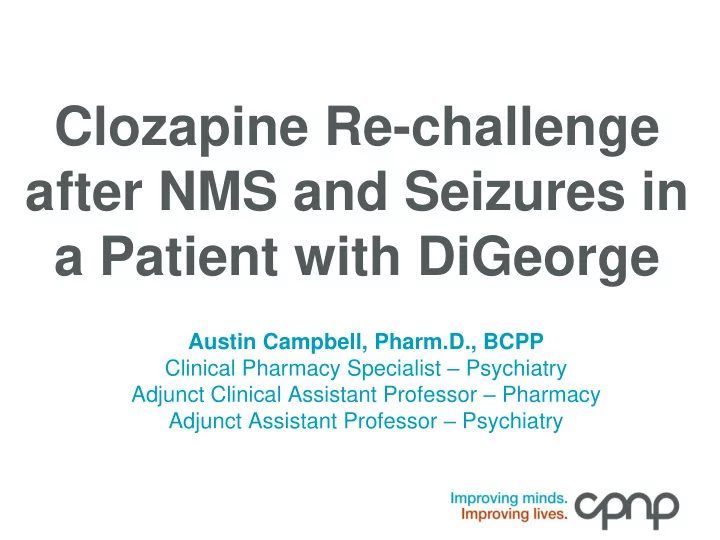

Clozapine Re-challenge after NMS and Seizures in a Patient with DiGeorge Austin Campbell, Pharm.D., BCPP Clinical Pharmacy Specialist – Psychiatry Adjunct Clinical Assistant Professor – Pharmacy Adjunct Assistant Professor – Psychiatry
Disclosures • Austin Campbell has no conflicts of interest to disclose for the session, nor will there be any off-label discussion of medications
Objectives 1. Discuss the clinical presentation of DiGeorge Syndrome and its association with schizophrenia 2. Identify the complications of treating schizophrenia in patients with DiGeorge 3. Review available evidence supporting clozapine rechallenge after serious adverse effects
Case • 25 year old Caucasian male • Admitted to acute psychiatric hospital for worsening aggression, auditory and visual hallucinations, suicidal and homicidal ideations • History of: – Moderate intellectual disability – Schizophrenia – diagnosed age 15 – DiGeorge syndrome – diagnosed age 16
Case • Medications Day 1: • Medications Day 16: – Fluphenazine 5 mg QID – Fluphenazine 5 mg TID – Olanzapine 25 mg HS – Divalproex ER 500 mg AM & 1000 mg HS – Quetiapine 500 mg HS – Clozapine 100 mg AM & – Clonazepam 1 mg TID 200 mg HS – Temazepam 30 mg HS – Citalopram 10 mg daily – Divalproex ER 500 mg AM & 1000 mg HS
Case • Day 16 – Temperature 105.2 °F – Creatine Kinase > 1100 units/L – Tremors and mild rigidity – Transferred to ICU where diagnosed with neuroleptic malignant syndrome (NMS) – Began 14 day washout • Day 19 – Moved from ICU to medicine unit • Day 24 – Transferred back to psychiatry – Experienced tonic-clonic seizure
DiGeorge Syndrome (DGS) • 22q11.2 deletion syndrome (22qDS) • Most common microdeletion syndrome – Estimated frequency 1:2000 to 1:4000 live births • Roughly 3 million base deletion • Highly variable: >180 clinical features described • Common features: “CATCH 22” – Conotruncal cardiac anomalies – Abnormal face – Thymic hypoplasia – Cleft palate – Hypocalcemia Bassett AS, Curr Psychiatry Rep . 2008; 10(2):148 Hoeffding LK, JAMA Psychiatry. doi:10.1001/jamapsychiatry.2016.3939
DGS Non-immunologic Clinical Findings Percent (%) 69 – 100 Palatal Anomalies 79 – 90 Speech Delay 45 – 90 Learning Disabilities 49 – 83 Cardiac Abnormalities Developmental Delay 75 7 – 70 Ophthalmologic Abnormalities 17 – 60 Hypocalcemia 9 – 60 Psychiatric Disorders 17 – 45 Skeletal Abnormalities 31 – 37 Renal Abnormalities Adapted from: DiGeorge (22q11.2 deletion) syndrome In: Basow DS, ed. UpToDate. Accessed 2/21/2017
DGS and Schizophrenia • Nearly 1/3 of individuals with 22qDS develop schizophrenia – Prevalence in schizophrenia: 1:100 • Represents the most highly replicated schizophrenia subtype – Possibly the first identifiable genetic subtype • No specific treatment recommendations for schizophrenia management – Standard approaches suggested Bassett AS, J Pediatr . 2011; 159:332 Bassett AS, Curr Psychiatry Rep . 2008; 10(2):148 Hoeffding LK, JAMA Psychiatry. doi:10.1001/jamapsychiatry.2016.3939
Case: What went wrong?
Clozapine and DGS; Butcher et al • Retrospective long-term safety and efficacy study conducted in Canada • Evaluated clozapine in 40 patients with schizophrenia – 20 patients with 22qDS and 20 controls matched for age and severity – All confirmed with molecular testing • Used medical records, extensive clinical histories, and semi-structured interviews Butcher NJ. Br J Psychiatry. 2015; 206(6):484
Results • Both groups demonstrated improvement on CGI-I scale (p=0.33) • Both experienced significant reductions in hospitalization • Median maintenance dose significantly lower in 22qDS group – 250 mg vs. 400 mg Butcher NJ. Br J Psychiatry. 2015; 206(6):484
Results Adverse Effect 22qDS, n (%) Control, n (%) Novartis trials (%) Sedation 15 (75) 14 (70) 39 Weight gain 10 (50) 7 (35) 31 Hypersalivation 10 (50) 9 (45) 31 Dizziness 9 (45) 3 (15) 19 Tachycardia 5 (25) 6 (30) 25 Seizures 8 (40) 0 (0) 3 Neutropenia 3 (15) 0 (0) < 3 Myocarditis 1 (5) 0 (0) 0.06 Butcher NJ. Br J Psychiatry. 2015; 206(6):484
NMS • To date, no case had been reported in a patient with DGS-associated schizophrenia • Estimated incidence NMS 0.02% - 0.03% • Mortality estimated 5.6 – 20% • Risk factors include: – High potency drugs , parenteral administration, rapid dose escalation, polypharmacy , other CNS disorders , dehydration • Risk of recurrence as high as 30% when rechallenged with same agent Citrome L. Clinical Schizophrenia & Related Psychosis . Fall 2016 Pileggi DJ. Annals of Pharmacotherapy . 2016; 50(11):973
Clozapine & NMS • May have an atypical presentation – Fever or muscle rigidity vs. having both • > 20 cases of clozapine-associated NMS reported in literature • Few provide information on successful rechallenge or rechallenge strategies Citrome L. Clinical Schizophrenia & Related Psychosis . Fall 2016 Pileggi DJ. Annals of Pharmacotherapy . 2016; 50(11):973 Anbalagan E. Psychiatr Q . 2014; 85:345 Shedlack KJ. Harv Rev Psychiatry . 2003; 11:334
Rechallenge Principles • If possible, recommend wash-out period of at least 14 days after NMS symptom resolution – Rechallenge has occurred within 5 days for patients experiencing intolerable effects due to antipsychotic discontinuation • Reevaluate patient risk factors and modify if possible • Utilize the “low and slow” method • Consider alternative antipsychotic Citrome L. Clinical Schizophrenia & Related Psychosis . Fall 2016 Pileggi DJ. Annals of Pharmacotherapy . 2016; 50(11):973 Anbalagan E. Psychiatr Q . 2014; 85:345 Shedlack KJ. Harv Rev Psychiatry . 2003; 11:334
Case • Days 31 – 32 – Patient transferred back to psychiatry on Divalproex ER only – Persistent hallucinations and aggressive behavior – Case conference and family meeting held – Clozapine restarted at 12.5 mg • Day 61 – Clozapine 137.5 mg/day (Clozapine = 319, Norclozapine = 89) – Patient brighter, able to participate in interview, hallucinations reduced – Discharged: Described as “brighter”
Questions? "What's right is what's left if you do everything else wrong." - Robin Williams
Recommend
More recommend